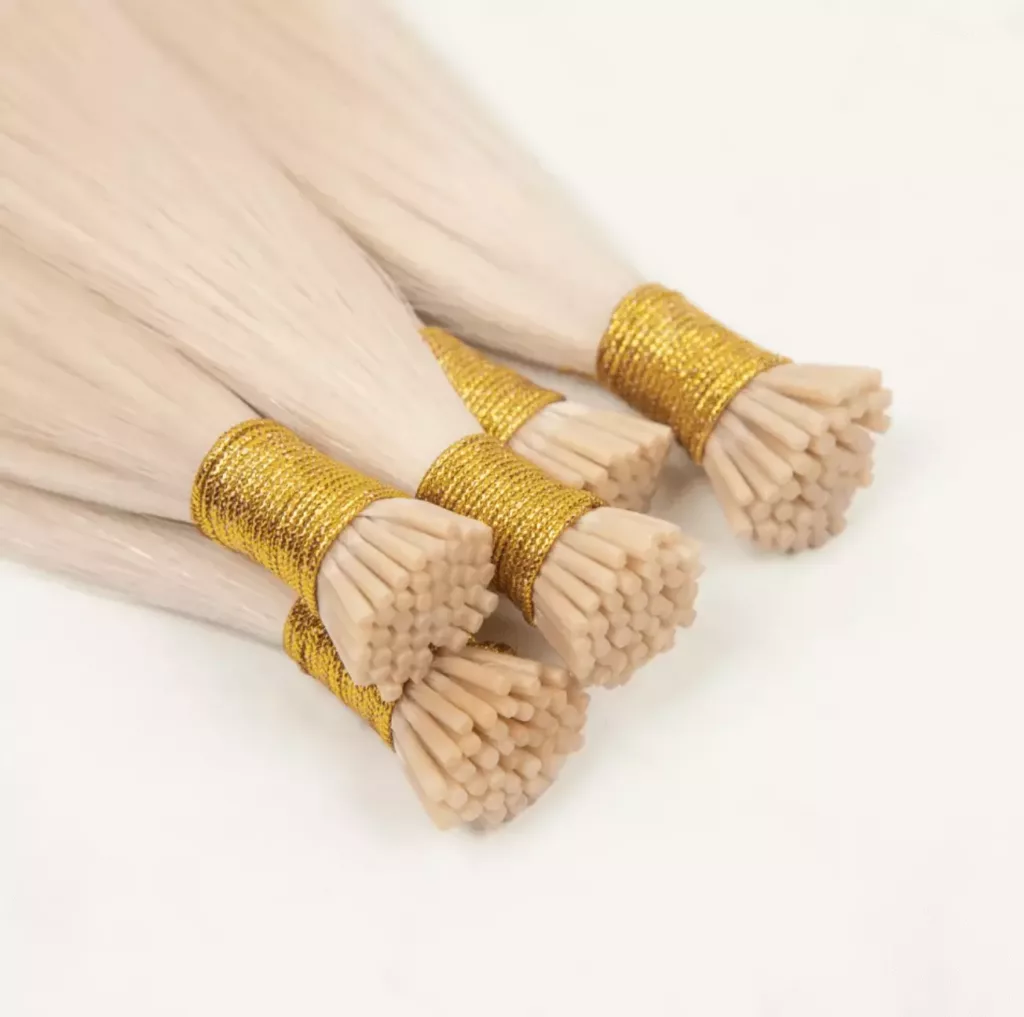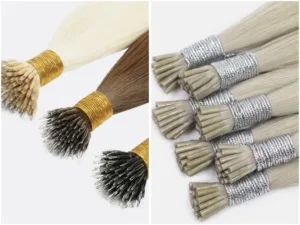As a professional stylist, you may be wondering about I tip extensions and their potential impact on your clients’ hair. This comprehensive guide delves into the benefits and risks associated with I tip extensions, equipping you with the knowledge needed to make informed choices for your clients.
I tip extensions, often referred to as keratin bond extensions, utilize small beads for installation. While they can be damaging if not applied or maintained properly, skilled application and proper aftercare can ensure a safe and stunning outcome. The effectiveness of these extensions largely hinges on the installation technique, the quality of the products used, and the aftercare routine implemented.

Curious about how I tip extensions function and how to mitigate any risks? Let’s explore the essential details, addressing common concerns while providing practical tips to keep your clients’ hair healthy and vibrant.
Understanding I Tip Extensions
What Are I Tip Extensions?
I tip extensions, or stick tip extensions, are installed using a no-heat method, making them ideal for clients seeking a damage-free solution. Each extension strand features a robust keratin “I” tip that is inserted into a micro-ring or bead. This technique allows for natural movement and seamlessly blends with the wearer’s hair, making I tip extensions an excellent option for enhancing hairstyles with keratin bonds.

Benefits of I Tip Extensions
Heatless application method
Easily blendable, creating natural movement
Long-lasting results with minimal visibility
Easy maintenance with regular salon visits

Why They Can Be Damaging
I tip extensions can indeed pose risks to natural hair if not handled correctly. Consider these critical factors that may lead to damage:
1.Improper Installation
Too Close to the Scalp: Applying extensions too near the scalp creates unnecessary tension, which can lead to traction alopecia over time. At the same time, if the top is too close to the scalp, the tip may directly poke the scalp and cause damage to the scalp.
Stress on Hair Follicles: The additional weight from the extensions can strain hair follicles, leading to weakening, thinning, or even loss of hair.
Low-Quality Beads:Choosing inferior beads can be detrimental. For instance, beads lacking silicone liners may damage natural hair, and poor-quality rings may fail to grip securely, causing extensions to slip and leading to further hair stress.
2.Bad Quality Hair Extensions
Inconsistent Texture: Low-quality hair often exhibits inconsistent textures, which can lead to tangling and increased friction during styling, resulting in breakage.
Poor Adhesion: Cheap keratin bonds may not adhere effectively in long-term, leading to slippage and hair shedding.
Diminished Longevity: Extensions of poor quality generally require more frequent replacements, which can place additional strain on natural hair.
3.Neglecting Aftercare
Inadequate Maintenance: Clients who disregard aftercare recommendations may find their extensions tangling, which can stress their natural hair and lead to loss.
Suitability Issues
Not Suitable for All Hair Types: I tip extensions may not be appropriate for very fine or damaged hair, as the added weight can exacerbate breakage.
Length of Natural Hair: Very short hair may not provide adequate support for I tip extensions, leading to discomfort and pulling.
By understanding these factors, stylists can guide clients towards safe and effective use of I tip extensions.
How to Minimize Damage from I Tip Extensions
To enhance the benefits of I tip extensions while minimizing potential risks, consider the following strategies:
1.Proper Installation Techniques
Consultation and Assessment: Always begin with a thorough consultation to evaluate the client’s hair type and condition, ensuring the extensions are suitable for them.
Correct Placement: Position extensions at least 10mm from the scalp to avoid tension and leave space for the I tips, ensuring they don’t poke the scalp. Use small, even sections for balanced weight distribution.
Avoid Overloading: Confirm that the total weight of the extensions is appropriate for the client’s hair density.
Choose High quality Beads:Choosing branded beads, or beads recommended by professional hair extensions artists, can effectively prevent the problem of beads falling off. Try to choose hair extension rings with silicone to minimize damage to natural hair.

2.Choosing Quality Extensions
To reduce risks from poor-quality hair, selecting high-quality I tip extensions is vital:
Research Suppliers: Opt for reputable suppliers known for premium extensions, and check customer reviews to assess quality.
Evaluate Hair Quality: Choose 100% human hair with consistent texture and color, steering clear of synthetic blends.
Inspect Keratin Bonds: Ensure keratin bonds are durable and flexible, designed for optimal adherence.
Test for Shedding: Inquire about shedding rates; high-quality extensions should exhibit minimal shedding.
Consider Longevity: Prioritize extensions marketed for durability to minimize the frequency of replacements.
Seek Professional Advice: Consult experienced stylists for recommendations on reliable brands.

3.Educating Clients on Aftercare
Aftercare Instructions: Provide clients with clear maintenance guidelines, emphasizing the use of sulfate-free and oil-free products.
Regular Maintenance: Schedule move-up appointments every 3 to 4 months to maintain the security and health of extensions.
Brushing Techniques: Instruct clients on proper brushing methods to avoid pulling and damage.
Limit Manipulation: Advise clients to minimize excessive styling to reduce wear and tear on extensions.

4.Safe Removal Practices
Professional Removal: Always recommend that clients seek professional assistance for removal to prevent damage to their natural hair.
Use of Appropriate Tools: Educate stylists on specialized tools designed for safe removal.
5.Customized Solutions for Different Hair Types
Tailored Recommendations: For clients with fine or damaged hair, suggest lighter alternatives or different types of extensions that exert less stress.
By implementing these strategies, stylists and clients can significantly reduce the risks associated with I tip extensions. Prioritizing education, proper technique, and diligent maintenance will ensure a positive experience with beautiful results.

FAQ
Q1: How long do I tip extensions last?
A: With proper care, premium full cuticle grade hair extensions can last up to 12 months or longer.
Q2: Can I color hair after installing I tip extensions?
A: It’s best to color hair before installation. Post-installation coloring should avoid direct contact with the beads and the natural hair.
Q3: Are I tip extensions suitable for all hair types?
A: Ideal for medium to thick hair, they may not be suitable for very fine or damaged hair.
Q4: What products should I avoid when wearing I tip extensions?
A: Avoid oil-based or sulfate-containing products as they can weaken bonds.
Q5: What’s the difference between I tip and tiny tip extensions?
A: Tiny tip extensions have smaller tips, ideal for clients with finer hair, providing a more discreet finish.
Q6: Can I tip extensions cause hair loss?
A: Improper installation or heavy extensions can lead to hair thinning or loss, but professional installation minimizes this risk.
Q7: How frequently should extensions be adjusted?
A: Maintenance appointments should occur every 3-4 months.
Q8: Do I tip extensions hurt during installation?
A: Properly installed extensions should feel comfortable without pain or discomfort.
Q9: How many packs of I tip extensions are needed for a full head?
A: Typically, 100-200 strands (2-4 packs) are sufficient for a full head.
Q10: Can clients swim with I tip extensions?
A: Clients can swim but should wear a protective cap and wash extensions immediately after exposure to chlorine or saltwater.

where to buy i tip hair extensions
Hibiscus Hair Manufacturer has been dedicated to producing high-quality I tip hair extensions for 25 years and is a recognized leader in the industry. If you are interested in finding a reliable hair extensions supplier, please visit our website for more information:
I Tip Hair Extensions
Conclusion
By recognizing the potential risks and adhering to proper installation and care guidelines, both stylists and clients can enjoy the aesthetic benefits of I tip extensions without compromising hair health. Emphasizing education, high-quality products, and regular maintenance will foster a successful and enduring extension experience.




